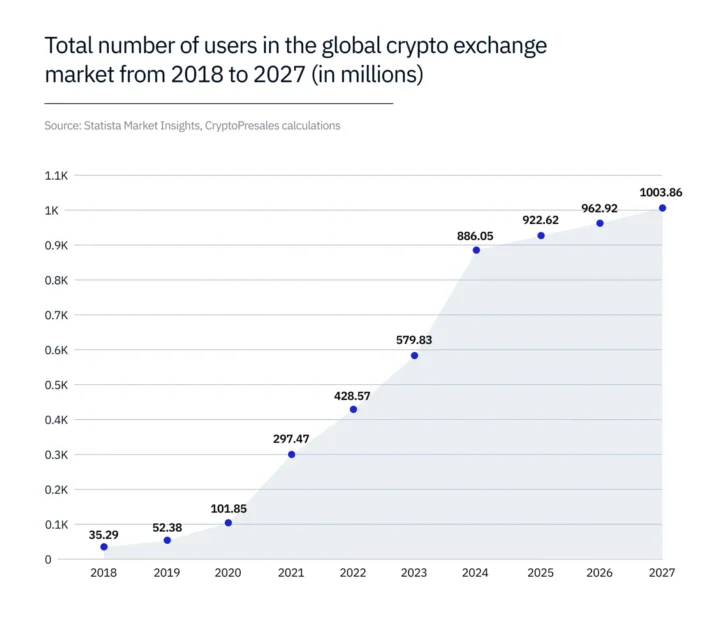Crypto Exchanges 101: What They Are and How They Work

Over the past decade, the cryptocurrency market has evolved from a niche space for enthusiasts into a full-fledged financial sector with daily trading volumes reaching hundreds of billions of dollars. At the center of this ecosystem are cryptocurrency exchanges.
According to data from CryptoPresales, the number of crypto exchange users is expected to surpass one billion by 2027.

Crypto exchanges enable users to store, buy, sell, and trade digital assets. They provide the majority of the market’s liquidity, influence cryptocurrency pricing, мand make digital assets accessible to a global audience.
Let’s take a closer look at what crypto exchanges are, the types that exist, and how they work.
What Is a Crypto Exchange?
A cryptocurrency exchange is a digital platform designed to facilitate the buying, selling, trading, and storage of cryptocurrencies. It acts as an intermediary between market participants, providing the technical and financial infrastructure needed to conduct transactions with digital assets.
Unlike traditional exchanges, such as stock or commodity markets, crypto exchanges operate 24/7 and are not bound by geographic borders or national currencies. The key distinction lies in the type of assets being traded. Stock exchanges deal in securities issued and regulated by government authorities, while crypto exchanges operate with blockchain-based cryptocurrency tokens.
It’s worth noting that regulators often classify certain digital assets traded on crypto exchanges as securities, leading to legal disputes and increasing pressure on the industry. In the United States, the Securities and Exchange Commission (SEC) has consistently argued since 2023 that some tokens meet the criteria of investment contracts under the Howey Test. As a result, exchanges such as Binance, Coinbase, Kraken, and Bittrex have faced lawsuits, investigations, and demands to restrict trading of specific assets. As of 2025, these legal proceedings are ongoing, though SEC representatives have pledged to reconsider how the Howey Test applies to digital assets.
The main functions of a cryptocurrency exchange include:
- Creating and executing orders for the purchase and sale of digital assets
- Automatically matching orders within the system to ensure trades are executed at optimal prices
- Enabling crypto-to-crypto and crypto-to-fiat conversions
- Providing users with a secure infrastructure for asset storage
- Maintaining sufficient trading volume to support stable price formation
In essence, a crypto exchange is a cornerstone of the digital asset ecosystem. It combines the roles of a marketplace, a financial institution, and a technology platform.
Types of Crypto Exchanges
The modern digital asset market includes several types of crypto exchanges that differ in their degree of centralization, governance model, and methods of asset custody. Each classification can be considered separately.
By Degree of Centralization
Depending on how much a cryptocurrency exchange relies on a central authority, they can be divided into the following categories:
- Centralized Exchanges (CEX) — controlled by a single organization that manages the infrastructure, holds users’ assets, and processes transactions. Trading takes place within the system — the exchange manages orders, determines liquidity, and sets prices. The main advantages of CEXs include high liquidity, fast order execution, and access to a wide range of instruments, from spot trading to derivatives markets. The primary risks stem from centralized custody and dependence on the operator’s policies, which may include withdrawal restrictions or account freezes.
- Decentralized Exchanges (DEX) — operate on smart contracts without a central operator. Users trade through liquidity pools, which increases transparency and gives them full control over their funds, reducing the risk of central server breaches. However, DEXs often lag behind centralized platforms in terms of transaction speed and liquidity levels. Additionally, users bear full responsibility for managing their private keys and securing their assets.
- Hybrid Exchanges — combine centralized management with elements of decentralization. They may use decentralized solutions for asset custody while maintaining centralized order processing, or allow users to choose between both operating modes.
According to various analytical platforms, the total number of crypto exchanges worldwide varies depending on the methodology used. For instance, blockspot.io reports 1,735 cryptocurrency exchanges, while CoinGecko lists 1,088 DEXs and 203 CEXs. Meanwhile, Messari provides a more conservative estimate — 159 CEXs and 111 DEXs.
Based on CoinGecko’s Q3 Crypto Industry Report, in the third quarter of 2025, spot trading volume on the largest centralized exchanges reached $5.1 trillion, marking a 31.6% increase compared to the second quarter. At the same time, Binance data shows that spot trading volumes on decentralized platforms rose by about 25% in Q2 of 2025, reaching $877 billion.
By Governance Model
Cryptocurrency exchanges can be broadly categorized based on who manages the platform:
- Corporate Exchanges — owned by commercial companies and operated traditionally as profit-oriented legal entities. Decision-making is centralized and handled by the company’s management team.
- Autonomous Exchanges — governed by Decentralized Autonomous Organizations (DAOs). Holders of governance tokens can vote on key protocol changes, fee structures, or the listing of new assets.
- Hybrid Exchanges — platforms where some decisions are put to community vote, while the overall operational framework remains centralized.
By Asset Custody Model
Depending on how client assets are stored, crypto exchanges can be classified into:
- Custodial Exchanges — users’ funds are stored in exchange-controlled wallets, and the platform retains full control over private keys. This is the standard model for centralized exchanges.
- Non-Custodial Exchanges — users maintain full control over their funds and private keys. The exchange merely provides an interface for trading through smart contracts.
- Hybrid Exchanges — some platforms allow users to choose between keeping assets in a custodial account or connecting a non-custodial wallet such as MetaMask.
The structural classification of cryptocurrency exchanges reveals that their differences extend beyond technology to encompass organizational aspects as well.
It is worth noting that despite this multi-layered classification, in practice, crypto exchanges are most often divided into two primary categories: centralized (CEX) and decentralized (DEX). This distinction reflects a fundamental difference in governance and control over assets.
According to a 2023 report by the World Federation of Exchanges (WFE), approximately 60% of trading platforms in the crypto market operate under a centralized model, while only 40% are decentralized.
How Do Crypto Exchanges Work?
The operation of cryptocurrency exchanges is based on a combination of infrastructure solutions that enable digital asset trading and financial technologies that influence liquidity, transaction security, and overall market functioning.
Let’s explore how crypto exchanges work by comparing the functionality of centralized and decentralized platforms.
User Registration and Identification
On CEXs, users must complete a standard Know Your Customer (KYC) procedure to access trading. This process typically involves registering with personal details and verifying identity by uploading a government-issued ID and a video selfie. In addition, centralized exchanges must comply with Anti-Money Laundering (AML) requirements, monitoring suspicious transactions and sharing such data with regulators upon request. This system ensures compliance with legal standards and builds trust among institutional clients, but it also reduces user privacy.
On DEXs, registration as such does not exist. To start trading, users simply connect their crypto wallet. The exchange does not store personal data or require KYC verification, preserving user privacy and autonomy. However, this model makes fund recovery impossible in case of user error or technical malfunction, increases exposure to hacking risks, and complicates interactions with regulators and traditional financial institutions.
Trading Mechanism
Most CEXs operate using an order book model — a ledger of buy and sell orders where traders specify price and volume. The exchange automatically matches opposing orders, ensuring efficient trade execution. This approach provides transparent price formation and high liquidity.
DEXs, on the other hand, typically rely on Automated Market Makers (AMMs) — algorithms that determine prices based on mathematical formulas and liquidity pools funded by users. This allows trading without intermediaries but can lead to price fluctuations in periods of low liquidity.
Asset Storage and Security
Centralized exchanges store users’ assets in two main forms:
- Hot wallets connected to the internet and used for instant transactions
- Cold wallets kept offline and used for long-term reserve storage
This model is convenient but requires users to trust the exchange operator. In the event of a hack or internal failure, users may lose access to their funds. To mitigate these risks, major CEXs implement multi-layer authentication, deposit insurance, and even compensation programs.
For example, Binance’s insurance fund was expanded to $1.2 billion in 2023. It is also worth noting that independent solutions have emerged in the market to reduce risks associated with trading and storing assets on centralized exchanges. One such innovation is the Off-Exchange trading system developed by Fireblocks.
DEXs, by contrast, do not hold users’ funds at all as assets remain in personal wallets. Smart contracts simply execute transactions, eliminating intermediaries and removing the risk of theft from centralized storage. However, security in this case depends entirely on the user: losing private keys or interacting with a vulnerable smart contract can result in permanent loss of assets.
Liquidity and Price Formation
On CEXs, liquidity is mainly provided by market makers who continuously place buy and sell orders, maintaining a narrow spread between prices. This ensures stable quotes and allows large orders to be executed quickly without significant market impact. Prices are formed by supply and demand within the order book and further adjusted through arbitrage between exchanges, helping align market prices.
On DEXs, liquidity is supplied by users who deposit assets into liquidity pools. In return, they receive a share of trading fees and, in some cases, reward tokens. Pricing is determined automatically through smart contract formulas, where prices often fluctuate proportionally to the balance of assets in the pool. This model ensures continuous liquidity but, at low volumes, can cause price volatility and slippage during large trades.
Fee Structure and Profit Distribution
On CEXs, fees are set by the platform operator and typically include charges for trading, deposits, withdrawals, and, in some cases, additional fees for margin or derivatives trading. Exchange revenue comes from these fees, token listings, and premium services. Users generally do not share in the profits — earnings are retained by the exchange’s parent company.
On DEXs, fees are embedded in smart contracts and distributed among ecosystem participants — primarily liquidity providers (LPs) and governance token holders. User earnings come from trading fees collected in liquidity pools. The reward structure is transparent and governed by the protocol rather than a centralized operator.
Key Differences Between Centralized (CEX) and Decentralized (DEX) Exchanges:
| Stage | Centralized Exchange (CEX) | Decentralized Exchange (DEX) |
| Registration and Access | Requires user registration and identity verification (KYC/AML) | No registration required — users simply connect a crypto wallet |
| Control Over Funds | Funds are held in exchange accounts (custodial model) | Funds remain in the user’s wallet (non-custodial model) |
| Trading Mechanism | Trading through an order book — a system of buy and sell orders | Trading through smart contracts and liquidity pools |
| Trade Execution | Orders are matched and settled within the exchange’s internal system | Transactions are executed algorithmically on the blockchain network |
| Fees | Fixed trading fees set by the exchange operator | Network fees plus a percentage for using liquidity pools |
| Speed and Liquidity | High execution speed and deep liquidity | Speed depends on network load, and liquidity on pool size |
Regulation and Legal Framework
The regulation of cryptocurrency exchanges has gradually become one of the central topics in global financial policy. In the early years of the crypto market, exchanges operated largely outside the legal framework, but today, governments are working to establish clear rules aimed at protecting investors.
Most countries are building their regulatory systems around Anti-Money Laundering (AML) and Know Your Customer (KYC) standards. Crypto exchanges are required to collect user data, monitor suspicious transactions, and report such activity to regulators.
European Union
Between 2024 and 2025, the European Union began the phased implementation of the Markets in Crypto-Assets (MiCA) regulation, which sets requirements for the registration and supervision of crypto service providers. Exchanges operating within the EU must:
- Obtain a license
- Disclose information about tokens listed on their platforms
- Ensure consumer protection
- Safeguard client funds in compliance with established standards
This legislation represents the first comprehensive regulatory framework defining unified rules for crypto businesses across Europe.
United States
The U.S. cryptocurrency market remains regulated by several agencies:
- The Securities and Exchange Commission (SEC) requires exchanges that trade security tokens to register as securities trading platforms.
- The Commodity Futures Trading Commission (CFTC) oversees crypto derivatives markets.
- The Financial Crimes Enforcement Network (FinCEN) enforces AML compliance.
This fragmented approach creates legal uncertainty but also strengthens oversight of the market.
Asia and Other Regions
Across Asia, regulatory approaches range from strict oversight to innovation-driven flexibility. In Singapore, the Monetary Authority of Singapore (MAS) requires crypto platforms to obtain licenses and provide proof of reserves. Japan, one of the first countries to implement exchange licensing back in 2017, continues to tighten its supervision of asset custody.
Meanwhile, the UAE, Hong Kong, and South Korea are strengthening exchange regulations by introducing licensing frameworks and investor protection measures while developing regulatory sandboxes that allow international companies to test new products and business models in a controlled environment.
Strict regulatory requirements increase operational costs but also foster greater trust among institutional investors. Exchanges that comply with KYC/AML rules and hold valid licenses gain access to banking services and corporate clients, driving the institutionalization of the crypto market.
For decentralized exchanges (DEXs), however, the situation remains challenging. Their governance models do not include a legal entity, which complicates the application of traditional legal norms. As a result, regulators are increasingly targeting intermediaries — such as wallet providers, cross-chain protocol operators, and developers of applications that facilitate access to DEX platforms.











